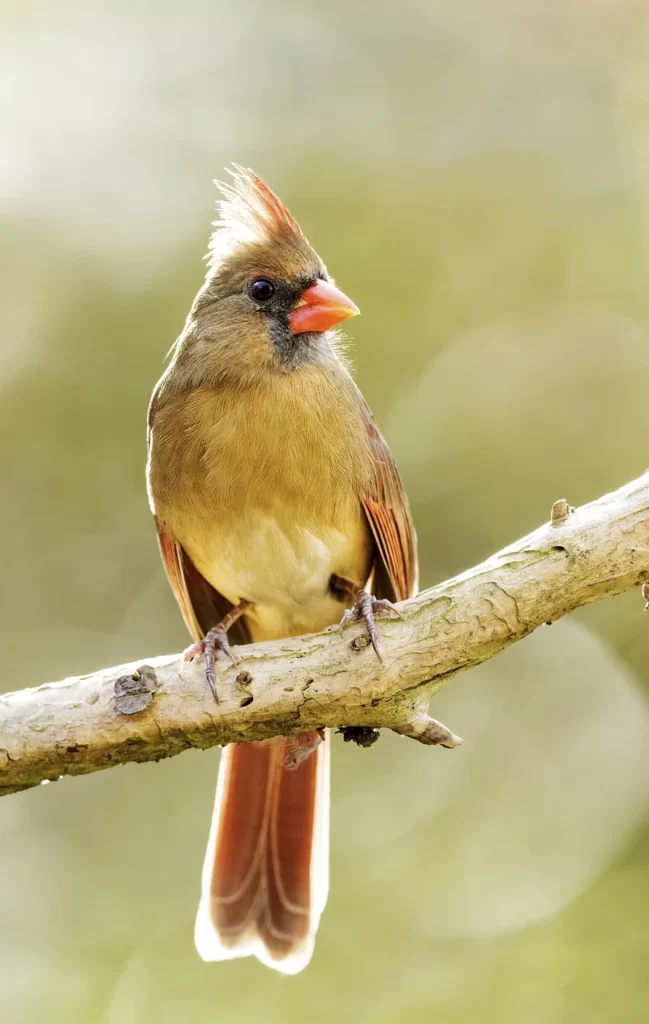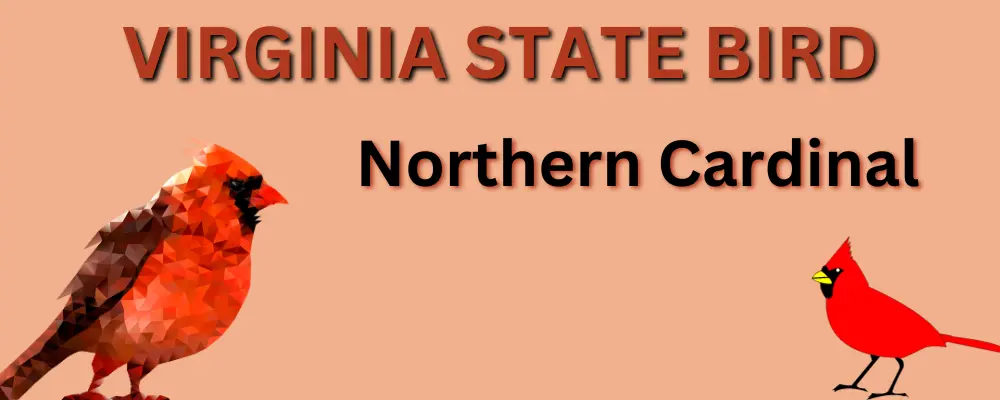Virginia is a state that boasts of extraordinary mountain ranges, scenic coastlines, and rich historical heritage. It is also home to a variety of wildlife, including many species of birds. Among them, one stands out as the official virginia state bird : the northern cardinal. In this blog post, we will explore what makes this bird so special and why it was chosen as the state symbol.
Table of Contents
Why is the Northern Cardinal the virginia state bird?

In 1776, Virginia declared its independence, making it one of the first colonies to do so. However, it took almost 200 years for this state, often referred to as the “Cavalier State,” to officially choose its state bird. It wasn’t until 1950 that the Virginia General Assembly came together and made a decision.
They picked the Northern cardinal as Virginia’s official state bird. This bird, often called a redbird, is a type of finch. It’s native to Virginia, and it’s known for its vibrant red plumage. The bird’s striking colors caught the attention of the state’s early European settlers, who noticed that it resembled the robes worn by cardinals in the Catholic Church. Since the colonial era, the people of Virginia have cherished the joyful songs of the state bird.
So, the Northern cardinal, with its bright red feathers and melodious tunes, proudly represents the “Cavalier State” as the Virginia state bird.
When did the Northern Cardinal become the state bird for Virginia?

Virginia’s Patient Decision: Virginia, one of the earliest states to join the United States, became a state on June 25, 1788. However, it took quite some time before they settled on the Northern Cardinal as their official state bird. The decision to honor this beautiful bird didn’t come until January 25, 1950.
Common Ground with Neighboring States: Virginia wasn’t alone in recognizing the appeal of the Northern Cardinal. Six other states – Indiana, Ohio, Illinois, North Carolina, West Virginia, and Kentucky – also embraced this bird as their state bird. This shared choice reflects a common appreciation for the Northern Cardinal’s unique qualities.
The Northern Cardinal is an enchanting bird, and Virginia, along with these other states, saw something truly special in it.
Is Flower Knows FDA Approved? 2023
What Is Google Finance Widget ?
Japanese vs Korean Skincare: “Mochi Skin” vs “Glass Skin”
What Are The Best Insoles For Plantar Fasciitis in 2023
What does the state bird of Virginia look like?
Let’s take a closer look at the Northern Cardinal’s appearance. The Northern Cardinal is a medium-sized bird, and it’s part of the finch family. You can easily recognize it by its special features:

For the Male Cardinal:
- The male cardinal is predominantly bright red, like a little red beacon in the trees.
- It sports a striking black mask around its eyes and bill.
- You’ll notice a unique crest on its head.
- It has a thick cone-shaped bill, perfect for cracking open seeds.
- A long tail adds to its elegant appearance.
- Both its bill and legs are colored in a lovely shade of red-orange.

For the Female Cardinal:
- The female cardinal, on the other hand, is mostly brown, with hints of red in its wings, tail, and crest.
- Similar to the male, she also has the red-orange bill and legs.
What’s even more fascinating about these birds is their melodious songs. They can serenade you with a delightful mix of whistles, trills, and even mimic the sounds of other birds. Now, you can easily spot and appreciate Virginia’s state bird, the Northern Cardinal.
How do northern cardinals live and behave?
The Virginia State Bird, the Northern Cardinal, is a remarkable bird with some unique habits. These birds, which do not migrate, often choose to set up their homes close to where they were born, typically within a mile. They love to nest in yards or gardens, usually in shrubs, and in the wild, they thrive in shrubby areas. In Virginia, you can find many of these vibrant red birds in suburban wooded areas, swamps, streamside thickets, and amidst the lush vegetation. Interestingly, they don’t build their nests too high off the ground, usually just one to five feet up.
A Long Life with Unique Mating Habits
The Northern Cardinal has a relatively long lifespan, typically living for 13 to 15 years. When they reach one year of age, they become sexually mature, and the males start establishing their breeding territories. It’s a fascinating sight when the females choose their mates from the young, single Northern Cardinals. Their courtship is quite complex and involves a romantic practice known as mate feeding. The male, as a good provider, hunts for dinner and then flies to his mate to feed her beak-to-beak. From a distance, it may even appear that they’re sharing a loving kiss.
Songs for Communication
One of the most charming aspects of the Northern Cardinal’s behavior is their use of songs as a means of communication. Listen for their songs that sound like “purty-purty-purty” or “cheer-cheer-cheer.” These songs are often exchanged between couples as they go about their daily activities. It’s not just for their musical pleasure; it also serves as a form of protection from potential danger.
Family Dynamics
In the Northern Cardinal family, roles are quite distinct. While the male is responsible for hunting for food, the female takes care of gathering nest materials, building the nest, incubating the eggs, and looking after the young ones once they hatch. While it may seem uneven, it’s a well-coordinated partnership. The male must provide food not only for his mate but also for the entire family, all while keeping a watchful eye for any potential threats. They even use their songs to communicate their locations and alert each other to approaching predators, helping to protect their offspring.
Two Broods a Year
These Virginia State Birds have a busy family life. They typically have two broods of chicks each year. The eggs require an incubation period of 11 to 13 days. After just nine to 11 days, the baby birds leave the nest, a process known as fledging. Even after they leave the nest, their parents continue to hunt for them during their first month of life. However, they gradually join a juvenile flock and start exploring the world on their own at about one month of age.
The Northern Cardinal’s life in Virginia is a captivating tale of resilience, partnership, and nurturing, making it a beloved symbol of the state as Virginia’s State Bird.

What do Northern Cardinals eat?
Northern Cardinals have a particular fondness for food, but they’re a bit picky about where they dine. You’ll often find these lovely birds hunting for their meals in the cozy tree lines, shrubs, and amidst the dense foliage of Virginia.
What’s interesting is that, unlike their more selective counterparts in some other states, Virginia’s Northern Cardinals have a more adventurous palate. You can call them “omnivores” because they’re open to trying a bit of everything. They balance their diet by enjoying both insects and plant-based fare.
When it comes to their preferred meat dishes, Northern Cardinals have a taste for beetles, cicadas, grasshoppers, and snails. On the other side of the menu, their favorite vegetation dishes include oats, sunflower seeds, and a medley of fruits, with berries taking the top spot. And here’s a quirky tidbit: they’ve been spotted sipping on maple sap, and they don’t even have to tap the trees themselves; they just find holes created by sapsuckers for a convenient drink!
These culinary preferences make them fascinating and adaptable creatures that add to the charm of being Virginia’s state bird.
Where can you find Northern Cardinals?

Northern Cardinals are pretty common birds in Virginia, known as the Virginia state bird. They like to hang out in places like woods that are growing back after being cut down (we call this “second growth”), and they’re often seen near the edges of forests, shrubby areas, and parks. But here’s the cool thing about them: they’re quite adaptable! They don’t mind living in gardens, even in busy cities, as long as there are some bushes and plants around.
Now, while you won’t spot many of these lovely red birds in the middle of big cities, coastal marshes, or deep, old forests, you can usually find them just about everywhere else. If you want to meet a Northern Cardinal, try taking a stroll in your local park – you’ll likely hear their distinctive calls or catch a glimpse of them.
Another trick to find them is by setting up a bird feeder in your backyard and patiently waiting. As long as you have some greenery around, a Northern Cardinal or two will probably drop by for a snack.
When it comes to nesting, these special birds like to make their homes in areas with lots of bushes and small trees. The lady cardinal is the architect in the family, using little things like rootlets and twigs to build a cup-shaped nest, and she’s good at hiding it amidst all the thick plants.
Both the mom and dad cardinal work together to feed their baby birds once they hatch. The youngsters leave the nest about ten days after they’re born, but their parents keep looking out for them and feeding them for at least another couple of weeks.
You must be know it
What is the state bird of Virginia?
The state bird of Virginia is the Northern Cardinal.
Why is the Northern Cardinal the state bird of Virginia?
The Northern Cardinal is the state bird of Virginia because this beautiful bird is one of the most commonly seen birds in the state.
When did Virginia choose its state bird?
Virginia chose its state bird on January 25th, 1950.
What other states have the Northern Cardinal as their state bird?
Other states that have the Northern Cardinal as their state bird are Illinois, Indiana, Kentucky, North Carolina, Ohio, and West Virginia.
What was the previous state bird of Virginia?
Virginia has only had one state bird. Virginia didn’t have a state bird until the Northern Cardinal was chosen in 1950.

